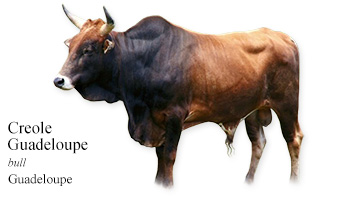


Creole Guadeloupe
(local/other name)
(most common name):
• Créole (Guadeloupe)
• Créole Guadeloupe (France)
(transboundary/brand name):
• Creole
Guadeloupe, an archipelago of eight islands, is an overseas department and region of France. It is part of the Lesser Antilles in the southern Caribbean Sea.
The Creole Guadeloupe initially developed from the same type of cattle imported from Spain and Portugal during the 1500s that became Criollo cattle. During the 1600s and 1700s, further importations from many other countries (including the UK, France and India) arrived. During the 1800s, the cattle of Guadeloupe achieved a degree of homogeneity (sameness).
The Creole Guadeloupe is well adapted to a dry tropical environment and displays a specific resistance to cowdriosis and dermatophilosis. This may be due to a direct introduction of African cattle; mtDNA studies show African haplotypes present in the Creole Guadeloupe (Magee, 2002).
A breeding association was formed in 1998. The main breeding goals include the improvement of:
• meat production
• nursing ability
• adaptation
Although, starting in the 1970s, mechanization of sugarcane transport eventually displaced Creole Guadeloupe draught oxen, competitions of bull pairs pulling loaded carts (gross weight 1–2.2 tons) up a muddy, hilly course of 100–180 meters has become a very popular spectator sport.
Creole Guadeloupe skin is black and coat color can be:
• fawn (mainly)
• grey
• red
• black
• white
• dun
• yellow
NOTE: When the term créole is used for livestock, it indicates native, but not aboriginal (existing before the arrival of colonists).
(French) Créole = nursling
(Spanish, contraction of ‘criadillo’) Criollo = a little nursling

This page was last updated on: 2024-06-04
You can also go to:
My Daily Cow® Guadeloupe and read about other Guadeloupe cattle breeds.
The Cow Wall® A-Z Cattle Breed Picture Reference to see other breeds of cattle in the world.